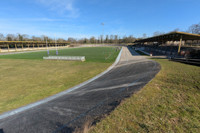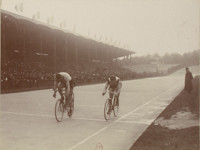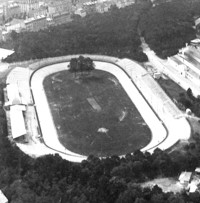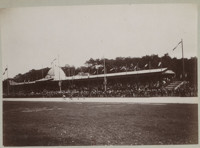Vélodrome Jacques Anquetil (Vélodrome de Vincennes)
| Capacity | 7 151 |
|---|---|
| Country | France |
| City | Paris |
| Clubs | Paris université club, Paris-Charenton XIII, Paris Cycliste Olympique, Vélo-Club des Vétérans Par. |
| Other names | Vélodrome municipal de Vincennes (1900–1987) |
| Nicknames | La Cipale |
| Inauguration | 03-04/06/1900 |
| Construction | 01/1900 – 06/1900 |
| Renovations | 1909 |
| Cost | FRF 300,000 ($152 M) |
| Design | Monsieur Lefebvre |
| Address | 51 avenue de Gravelle, 75012 Paris |
Advertisement
Vélodrome Jacques Anquetil – stadium description
What is the Vélodrome Jacques Anquetil in a nutshell?
The Vélodrome Jacques Anquetil (commonly known as the Vélodrome de Vincennes or la Cipale) was constructed in just a few months during the first half of 1900 as the main sports venue for the second edition of the modern Olympic Games, held in Paris that same year.
Since then, the facility has changed little, undergoing its most significant transformation in 1909 when a new roof was installed over the stands. The stadium features a 500-meter concrete cycling track, inside which there is a playing field that is mainly used for rugby.
The facility also played a role during the second Olympic Games in Paris in 1924, when track cycling competitions were held there. Between 1968 and 1974, the final stage of the famous Tour de France cycling race finished here. Since 1987, the arena has been named after the renowned cyclist Jacques Anquetil.
The velodrome is located in the Bois de Vincennes, in the eastern part of Paris. It is still actively used, although today it is more of an intimate sports facility, but one with a rich history.
How was the Vélodrome de Vincennes created?
The cycling track located in the Vincennes forest in Paris (Bois de Vincennes) was built in the first half of 1900 in preparation for the 1900 Olympic Games, organized as part of the World's Fair in Paris.
The velodrome was built about 300 m southeast of the previous municipal cycling track in the Bois de Vincennes, which had been opened just five years earlier. Initially, the plan was to modernize that facility for the Olympics, but later the idea of building a completely new arena emerged.
The plans for the new velodrome were drawn up by the conservator (supervisor) of the Bois de Vincennes, referred to in sources only by his surname – Monsieur Lefebvre. The construction costs amounted to 300,000 francs, which were shared equally between the exhibition organizers and the city authorities.
Construction of the new track began in January 1900 and was completed a few months later, in time for the Olympic Games.
The new velodrome was one of many facilities built in the Bois de Vincennes in connection with the exhibition – the site served as a complementary exhibition area, accompanying the main complex stretching along the Seine, from the Esplanade des Invalides to the Champ de Mars.
When was the Vélodrome de Vincennes inaugurated?
The official inauguration of the facility took place on June 3-4, 1900. The opening was marked by the 26th edition of the fête fédérale, a mass gymnastics festival attended by over 8,000 gymnasts from all over France, organized by the Union des sociétés de gymnastique de France (USGF).
On June 17, 21, and 24, 1900, the velodrome hosted the Grand Prix de Paris cycling competition, an event that had previously been held at the previous track in the Bois de Vincennes. The Grand Prix de Paris was associated with the new track for a long time, until its definitive end in the early 1990s.
What role did the Vélodrome de Vincennes play during the 1900 Olympic Games?
The new cycling track was the largest sports facility built for the 1900 Games and hosted the largest number of disciplines, which is why it is widely considered to be the main venue of the event.
The designation of the main arena of the 1900 Olympic Games is not really obvious. The athletics competitions were held at the Croix-Catelan stadium in the Bois de Boulogne, and the opening and closing ceremonies of the Games were not held at all.
The Games themselves (the second edition in the modern era) were not yet organized with great pomp and circumstance. It was an event accompanying a large world exhibition, which attracted about 50 million visitors between April and November 1900.
The sports competitions were held from May to October 1900, and instead of the name “Olympic Games”, the term “Concours internationaux d'exercices physiques et de sport” (International Physical Exercise and Sports Competition) was used much more frequently.
The new facility, due to its cycling track, was called a velodrome, but in fact, with a playing field inside, it was a multifunctional stadium where various types of competitions could be held.
As part of the Games, the facility in the Bois de Vincennes hosted competitions in five disciplines: gymnastics, cricket, cycling, soccer, and rugby. The gymnastics competitions were the first to take place (July 29-30), and the rugby matches were the last (October 14 and 28).
The older cycling track located nearby (from 1895; no longer in existence today) was used for archery competitions.
What were the further events in the history of the Vélodrome de Vincennes?
When was the new roof built at the Vélodrome de Vincennes?
In 1909, the stands at the Vélodrome de Vincennes received a new roof. Metal structures designed by the famous architect Jean Camille Formigé were erected on both sides. The distinctive roof, often described as Eiffel-style, has survived to this day.
What role did the Vélodrome de Vincennes play during the 1924 Olympic Games?
In July 1924, Paris hosted the Olympic Games for the second time. This time, the main venue for the event was the Stade de Colombes, but the Vélodrome de Vincennes hosted the track cycling competitions (four events).
When did the Vélodrome de Vincennes become located within the boundaries of Paris?
When the velodrome was built, the land on which it stood belonged administratively to the municipality of Charenton-le-Pont. It was not until 1929 that the Bois de Vincennes – and with it the cycling track – was incorporated into the boundaries of Paris (as part of the 12th arrondissement), even though the forest itself had been owned by the city since 1860.
When did the Vélodrome de Vincennes host the finish of the Tour de France?
In 1967, the Tour de France ended at the Parc des Princes stadium for the last time. The day after the finish of the last stage, on July 24, demolition of the cycling track at the Parc des Princes began.
It was then decided to move the finish of the Tour de France to the Vélodrome de Vincennes, where it took place for seven consecutive editions, from 1968 to 1974. During this period, the famous Belgian Eddy Merckx won the race five times, including four victories in the final stage ending at the velodrome.
Since 1975, the prestigious finish of the last stage of the Tour de France takes place on the Avenue des Champs-Élysées.
What name was given to the cycling track in the Bois de Vincennes?
The facility was initially known as the Vélodrome municipal de Vincennes, but it quickly acquired the nickname la Cipale (a distorted, shortened form of piste municipale). The facility is also commonly known simply as the Vélodrome de Vincennes.
In 1987, Jacques Anquetil, considered one of the best cyclists of all time, died. His career spanned the 1950s and 1960s, during which time the Frenchman won all the major tours and also won an Olympic bronze medal. In the same year, the velodrome in the Bois de Vincennes was named after him.
What work was carried out on the Vélodrome de Vincennes in the 21st century?
The venerable cycling track did not change significantly over the years, but its technical condition deteriorated significantly. In order to save the historic facility, the association “Sauvons la Cipale” (”Save la Cipale”) was established.
The city authorities finally decided to renovate the track, which was carried out between 2012 and 2015. The reopening of the track after renovation took place on July 6, 2015.
Was the Vélodrome de Vincennes used during the 2024 Olympic Games?
When Paris hosted the Olympic Games for the third time in 2024, the modest and outdated Vélodrome de Vincennes was overlooked – the only highlight was hosting the Paralympic torch relay on the opening day of the Paralympics (August 28).
What other events take place at the Vélodrome de Vincennes?
In 1982, the stadium hosted the final of the first edition of the French championship in American football. The Golden Helmet match was won by Spartacus de Paris, defeating Météores de Nogent 44–0.
The facility has also served as a film set for several cinematographic productions.
The stadium is used by rugby teams (Paris université club and Paris-Charenton XIII), as well as cycling clubs: Paris Cycliste Olympique and Vélo-Club des Vétérans Parisiens.
What does the Vélodrome Jacques-Anquetil look like?
The velodrome has a 500-meter, profiled cycling track with a concrete surface, inside which there is a playing field used mainly for rugby. Along the straights there are two grandstands, covered with a characteristic metal roof.
The facility has not changed much over the years – one of the biggest modifications was the construction of a new roof in 1909.
Advertisement
Pictures
-

15.10.2012 © Marc Verhille, Ville de Paris 
02.03.2025 © Bmazerolles (CC BY 4.0) 
08.07.1909 © Jules Beau 
ca. 1900 © Jules Beau 
1900 © Jules Beau 
1900 © Jules Beau
1909:
1900:
 StadiumDB
StadiumDB